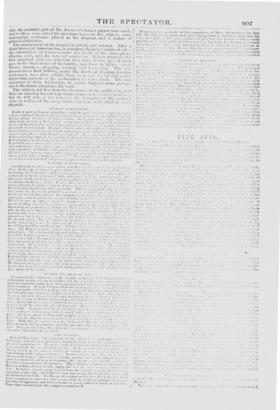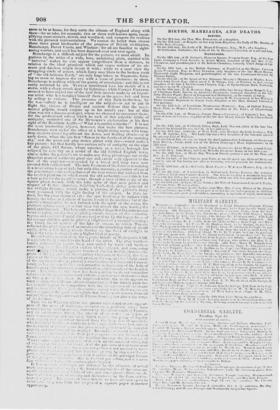FECE ARTS.
I..:.to • • . 1•:,•`11—
' aeh, 'Inc ..• ' of .1tter the
ta
• :11,A.
• • • • I.ttes 'ries the
,•.
• .
- • , •
NN
No: t,. 011.1 .... ....... It I 1. 5• I "-ts
seem to be at home, for they carry the climate of England along with them—let us take, fur example, two or three well-known spots, exem- plifying coast-scenery, downs, and woodland, and compare the realities with the pictured representations. We cannot do better than choose those three great landmarks of the progress of British civilization, Stonehenge, Dover Castle, and Windsor ; for all are familiar to sight- Seeing tourists, and each has been depicted over and over again. Stonehenge is a difficult suljeet for the painter, we must admit. Its position in the midst of a wide, bare, undulating plain, studded with barrows," makes its size appear insignificant from a distance, in relation to the ideal grandeur which our vague notions of its ob- scure and dateless origin invest it with ; while to a near view the straggling circle of stones, which fancy may liken to the broken teeth of " the old beldame Earth," arc only huge taken as fragments, form- ing no mass to impress the eye with a sense of greatness : in short, Stonehenge is nothing without the poetry ot' association ; and this is not easily rendered by art. Tunsert introduced into his sketch of it a storm, with a sheep struck dead by lightning; while COPLEY Fo.a.taxc seemed to have copied one of the neat little models made by an ingeni- ous artist who 11 is installed himself there as the genii's loci, and lives
by selling to visitors. The presence of this Jack-in-the-box, by the way—albeit he is intelligent on the subject—is apt to put to flight the. visions of Druids and ancient Britons that the semi- mental pilgrim would conjure up to his mind's eye: but of this class was not a fionous geologist, whom we chanced to encounter there; for the professional survey which he took of this palpable riddle of antiquity, reminded one of Sir Humeintv's exclamation at his first sight of the Belvidere Apollo—" What a beautiful stalactite!" It is not the most interesting objects, however, that make the best pictures. Stonehenge, seen under the effect of a bright rising moon, with long, deep shadows stretching athwart the down, and floating clouds—or at early- dawn, when the sun first "flames in the tbrehead of the morning sky," and the grass and gray stones glitter with dew—would make a Sne picture : bur that hardly less curious relic of antiquity on the edge of the plain, Oal Sarum, whose notoriety as a rotten borough has eclipsed its evict rite as a model of the old fortified English town, almost defies1.1 1
e painter's art to make any thing picturesque out of the
shapeless mass of earth—its great size and extent only apparent to the feet of the explerer—surrounded by a broad and deep fosae now covered with verdant turf. The only fraament of the fortress remaining is a molt:at:ring Leap of rude but rock-like masonry, a portion of one of the gate-towers—aloe embouchures of the four streets that radiated from the central platform on which stood the old cathedral,—and this is but a bare point for the pencil to seize ; though a view of this anglo of the square green mound, with the lofts- spire of that most perfcet and elegant of Gothic churches, Salisbury Cathedral, resin grae,fal in the twilight distance, would make a picture, if the painter's fancy were possessed v. HI the right feeling of the subject. Ia that, in- deed, lies the great charm of art the spot itself may be radiant with beauty. the forms and effects of nature lovely in themselves ; but if the painter's inlag191111011 he not imbued with the spirit of the scene, the prettiest :man; e, lour does hut attract time eve, leaving the mind uniniluvt.e,:. ■.mbowured in fdiage that GAO:SUOMI:011 loved to paint, ae:a .•:..alish pastoral : of the seclusion.
repose, and c.a.a.a.: • e are conjured up 1.y the happy faces of
his cottage chihlrea .1 ;he glowing brightness rd a smellier evealing : the broad lueent . 117,. 7: of the lake or stream, in which Wo.soN reflected the alai.: ezi of mountains or the crumbling ruin of an old meta:, SS 17:. clouds 1103tifeg 011 the flood of sauligat in which aa. e..1. are a higher kind of poetry. Do I • • the o; heialit of Shakspere's is a / 7, , • the 11,1011 f the artist. The gray weather- teatc:. : at:• - flirr.:nry.lipti by wails end bations attvtc'y:1! a- surface of the gri,u;,1, and coml,oing
most ,1; towers of the (,:d churell—he
greet, zzlir At:Li if the thlif, the •;,
-id green of the sca, anh 1•right:12:11:u
of tia, • eat a wail', hacioa of e, and forms ,; love, .• :.:.•1 attractive h.depet...;,:ht the /ELIO;+f a ....at:ha:les this (h. the coast. Ii. buun wu it, lint ren,e1,,IA•E ;.7 • dr,iYlr it di-tinett.,-,-; that impr,:,,,ed w i h : the (111.;•tie u1, 1'ATS to ",• , : . '7,14 the watery pain LE:- tr.,;; die .',;,1:ure that■,,•or:.. 'Lore Iv!! ••71.: fr,onall
If e tile verge Y•
an all a.. w tat aad re:: . coaa..
of -he '1.1.::. the are nyt ; et.",r.;,!1.•!:'• ,
111 'il.•
t.,, It, .• ;2. ati:;11,1 ;a
' • ill 01' •
'I . : •
r, wia.re the greater • :A and or.. a, appaar- w H. r • ,;,, ;,



























 Previous page
Previous page